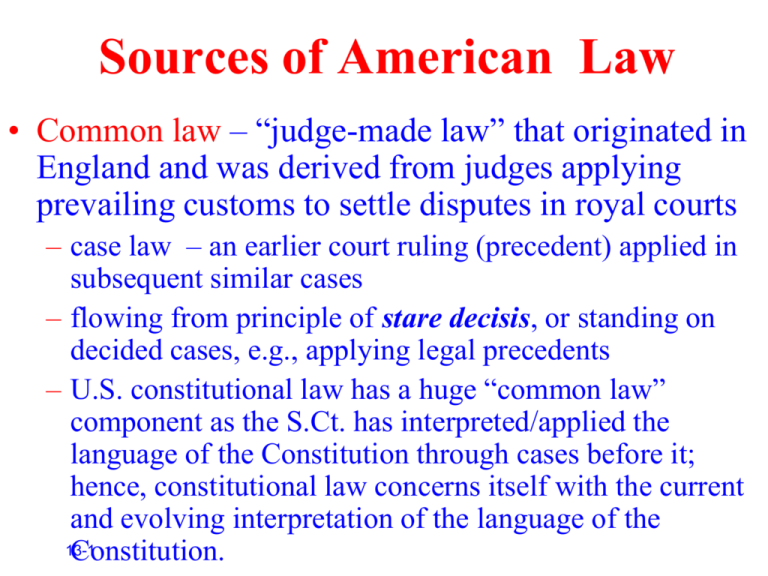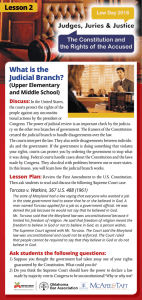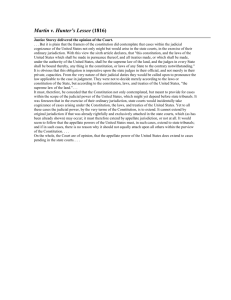Sources of American Law
advertisement

Sources of American Law • Common law – “judge-made law” that originated in England and was derived from judges applying prevailing customs to settle disputes in royal courts – case law – an earlier court ruling (precedent) applied in subsequent similar cases – flowing from principle of stare decisis, or standing on decided cases, e.g., applying legal precedents – U.S. constitutional law has a huge “common law” component as the S.Ct. has interpreted/applied the language of the Constitution through cases before it; hence, constitutional law concerns itself with the current and evolving interpretation of the language of the 13-1 Constitution. Sources of American Law, cont. • Constitutional Law – recognized as superior to other sources of law [Art. VI] – United States Constitution – State Constitutions • Statutory Law – law originating from authoritative lawmaking source, usually, a legislature • Regulatory Law – rules created by the regulatory agencies of the bureaucracy 13-2 Types of law based on subject matter of the law • Administrative law – law governing regulatory agencies and the bureaucracy • Civil law – defines individuals’ rights in relation to other individuals, private organizations and government • Criminal law – defines crimes against society and the public order Types of law based on subject matter of the law, cont. • Private law – provides benefits for or imposes duties and obligations on individuals and nongovernmental organizations • Public law – imposes duties and obligations on the government Development of U.S. Constitution • In theory, the British Empire was a unitary system with all power concentrated at the center [King in Parliament] • In practice, the Empire operated as a federal system with extensive authority delegated to the individual colonial governments • In reaction to the unitary claims of British rule, the first constitution adopted by an independent U.S. was a confederation, with an extremely weak central government and sovereignty vested in the individual states • Notice the one-branch structure of the Articles government; there was no Executive nor Judicial branch; Congress was unicameral and each state was equally represented and each had an absolute veto over any amendment to the constitution. The list of powers Congress lacked is much more impressive than those it had. Move for a New Constitution • By the mid-1780s it was clear to many that the confederal arrangement created by the Articles was too weak to provide the unity a large and diverse country needed • Feb., 1789 - Congress issued call for states to send delegates to Philadelphia in May for the “sole and express purpose of revising the Articles of Confederation.” A Constitutional Coup in 1789? • Delegates selected by their respective states were authorized merely to propose amendments to the Articles. • 55 delegates from 12 states eventually arrived in Philadelphia. • Rhode Island had refused to select or send any delegates. • What was the implication of Rhode Island’s action? • What were the alternatives for the delegates who had arrived in Philadelphia? Dispersion of Power in the U.S. Constitution • Given the circumstances under which the new constitution was adopted AND given the colonial experience of the Framers, it is no surprise that the new constitution was all about controlling and dispersing power to prevent its concentration and/or abuse: – Rule of law – the fundamental philosophy that the government itself and all officials exercising power/authority in its name are subject to the law; no one is “above the law.” Repudiation of the prevailing concept of “divine right” which put the sovereign above the law in the sense that “He gives law to all and receives it from none.” – Limited government – government can only exercise those powers delegated to it or which can be reasonably inferred from those delegated powers (Art. 1, Sec. 8, Cl. 18 – the so-called “elastic clause” or “necessary and proper” clause); repudiated the prevailing notions of “absolutism.” – Federalism – sovereign powers are divided between the states and the national government and represent a compromise position between the unitary and confederal forms previously experienced – Separation of Powers – national government’s powers are divided among “co-equal”/independent branches with a built-in system of “checks and balances” • legislative branch – is granted power to make laws • judicial branch – is granted power to resolve disputes under the law 2-5• executive branch – is granted power to administer/enforce laws Illustration of concepts of limited government and federalism Operation of concept of “checks and balances Selected Features of the Operations of the U.S. Judicial System Basic Judicial Requirements: Jurisdiction+Standing=“Justiciability” • Jurisdiction – a U.S. court must have either “original” or “appellate” jurisdiction over a case – jurisdiction is established in a constitution or statute – jurisdiction may be “general” or “specialized” – “federal question” – a claim arising under the Const. or laws of the U.S. • “Standing to sue – plaintiff must meet certain “qualifications” to bring a matter before a court • See feature on website for fuller development of these concepts 13-3 Supreme Court’s Jurisdiction – “Judicial Power” defined in Art. III, Sec. 2 • • – “Original jurisdiction” Art. III, Sec. 2, Cl. 1 • • – strictly limited to two types of parties very few cases annually arise under this provision “Appellate jurisdiction” Art. III, Sec. 2, Cl. 2 • • 13-5 Limited to “cases” and “controversies,” i.e., federal courts will hear only real legal disputes between actual adversarial parties No “advisory opinions,” although many state courts do this • subject to Congressional regulation granted at Court’s discretion through “writ of certiorari” the “Rule of 4” – 4 justices must vote to “take a case” Other Jurisdictional Issues – – – 13-5 “General jurisdiction” – power to hear any disputes arising under the Constitution, federal statutes, treaties, or state laws/constitutions which involve a “federal question,” i.e., one which impacts or implicates a right claimed under U.S. law “Specialized jurisdiction” – some federal courts can hear only certain types of cases based on their content, e.g., the Tax Court, Custom Court, and Court of International Trade [see diagram on p. 17] Geographical jurisdiction - District Courts and Courts of Appeals can only hear cases arising within their geographically-defined area, e.g., the Eastern District of Arkansas or the 8th Circuit Court of Appeals [see map on p. 18] Take It All the Way to the Supreme Court? • c. 11,000,000 cases originated in all courts (U.S. and states) each year • c. 50,000 appealed to U.S. Courts of Appeal – .0045 (>1/2 of 1%)of all cases • c. 7,500 appealed to U.S. Supreme Court – .15 (15%) of all cases appealed to U.S. Courts – .00068 (1/4 of 1% of all cases filed) • c. 70-90 accepted for “full review” (only 60 in 2003-04, 37 in 2006) – .012 (1%) of all cases appealed to Supreme Court – .0018 (2/10ths of 1%) of all cases appealed to Courts of Appeal – .0000081 (of all cases initiated annually) 13-5 Which Cases Reach the Supreme Court? The Court’s “Rule 10” • must be real case, not a hypothetical (issue of War Powers Act, i.e., since no president had violated it, the Court has not ruled on its constitutionality) • when two Courts of Appeal disagree • when a lower court’s ruling conflicts with an existing Supreme Court ruling • when a case has broad significance • when a state court has decided a substantial federal question • when the highest state court holds a federal law invalid, or upholds a state law that has been challenged as violating a federal law • when a federal court holds an act of Congress unconstitutional • when the Solicitor General is pressuring the Court to hear a case Options for Handling Appeals • Deny Appeal – upholds last lower court • Summary Judgment – disposes of case w/o full review • Full Review – – – – Submission of briefs, including amicus curiae briefs Oral argument (strict time limits imposed; Q and A format) Collective decision Formal (usually quite lengthy) opinion issued by Court and individual judges • Affirm – upholds the last lower court (end of the line) • Reverse – overturns last lower court • Remand – usually issued in conjunction with “reverse” – sends case back to the last lower for final disposition, but with new guidelines to be followed 13-6 Types of Court Rulings • • Unanimous ruling Majority ruling – – • • Concurring opinions (agree with ruling, but not reasoning) Dissenting opinions (disagrees with the ruling) Plurality ruling (when less than a majority of judges agree on a ruling; only happens when less than full Court participates, e.g. a 4-3 ruling; lacks power to establish a precedent) Deadlocked ruling - 4-4 or 3-3; has effect of upholding the ruling of the last previous court to hear case How Judges Decide: Judicial Philosophy • judicial activism – (the liberal position) – – – – not “overly bound’ by the actual language of the Constitution not bound by the meanings of words in 18th century not bound by precedent (unless it favors the desired end) views Constitution as an “evolving instrument” (by judicial interpretation) for achieving desirable social policy – views courts as primary players in “righting wrongs” the democratic branches won’t address • extensive use judicial review – the power of the courts to declare the acts of governmental officials unconstitutional (example of Constitutional common law) – c. 150 U.S. laws have been overturned [c. 200 S.C. opinions have been overturned by later a Court ruling] – c. 1,200 state laws have been overturned 13-8 How Judges Decide: Judicial Philosophy • judicial restraint – (the conservative position) – puts greater emphasis on the actual language of the Constitution – interprets words as they were used in the 18th century – asks what was the “intention” of the Framers – puts greater emphasis on precedent (unless it is recent precedent which has reversed older precedent) – defers to the democratic branches to establish social policy – rarely uses judicial review except to redress “flagrant” abuses of legislative or executive power 13-8 Qualifications for Judges • Formal/Constitutional qualifications/requirements: – NONE – Over ½ of all Supreme Court justices had NO prior judicial experience at the time of their appointment • Informal qualifications/requirements – training in the law – President’s political party – race, gender, religion (to maintain “balance” and to create impression of “symbolic” representation – prior judicial experience [as best gauge for “philosophical compatibility”] Judicial philosophy is the most important qualification! Does the Judiciary Threaten the Democratic Character of the American System? Checks on the Judiciary • Executive Checks – appointments (President’s most lasting legacy) • president can alter the course of Court rulings by his appointments • opportunities to appoint are a result of circumstances beyond his control (resignation or death of a justice) – implementation/enforcement of Court rulings • Court does not have ability to enforce its own rulings • dependent on executive branch to enforce orders if there is resistance or defiance • in extreme case, president could refuse to enforce a Court decision or order [Andrew Jackson did so in 1830s] 13-10 Does the Judiciary Threaten the Democratic Character of the American System? • Executive Checks • Legislative Checks – appropriation of funds to carry out rulings • If Court ruling requires action which will require funding, Congress could refuse to provide the money – constitutional amendments to overturn a Court ruling [has happened only 3 times, but it is the only way a ruling based on an interpretation of the Constitution can be overruled by another branch of government] – amending statutes to overturn Court’s rulings • If ruling based on the Court’s interpretation of a statute, the Congress can re-enact the law leaving out the provisions the Court found objectionable or clarifying the meaning of vague language 13-10 Checks on the Judiciary (cont.) • Executive Checks • Legislative Checks • Public Opinion – Widespread ignoring/resistance to decision (long defiance of school prayer/Bible reading rulings) – pressure executive for non-enforcement or half-hearted enforcement – influence judicial opinions (continued litigations trying to exploit every facet of the ruling) • Judicial Self-Restraint – tradition of restraint (various Courts and justices – narrow focus of judicial questions as opposed to broad questions of social policy – stare decisis itself puts a check on judicial assertiveness and innovations 13-10b




